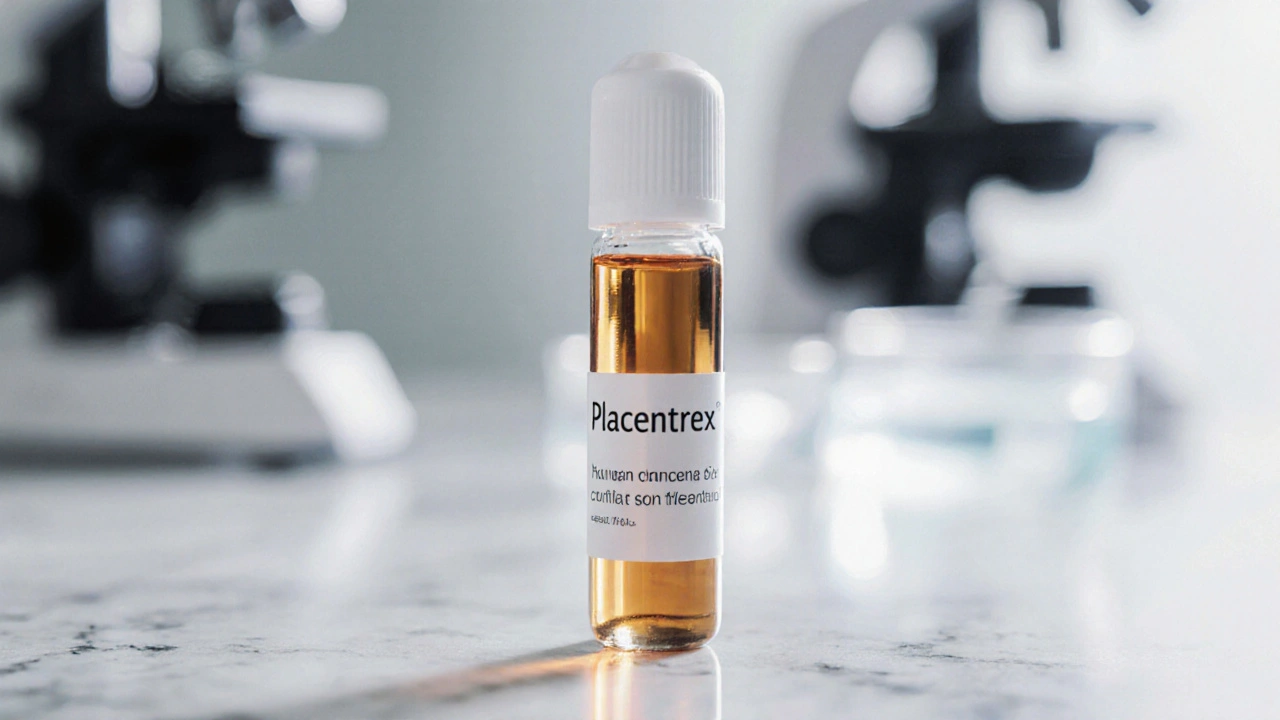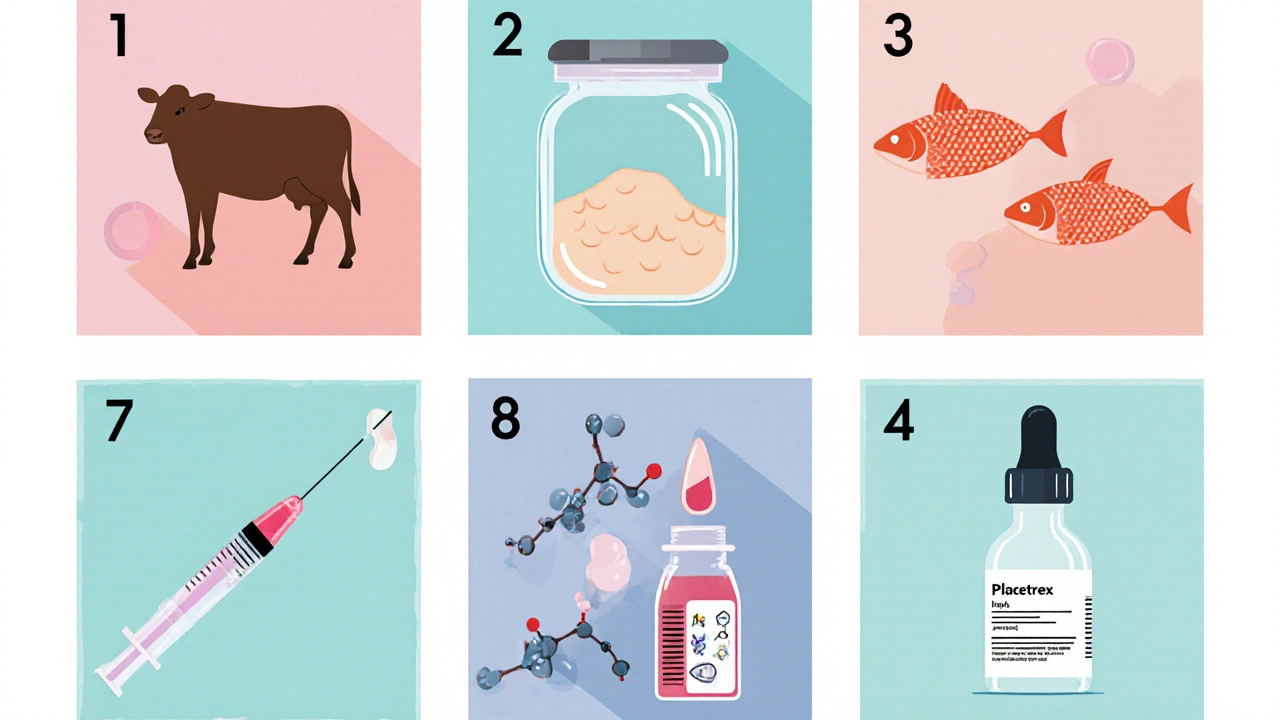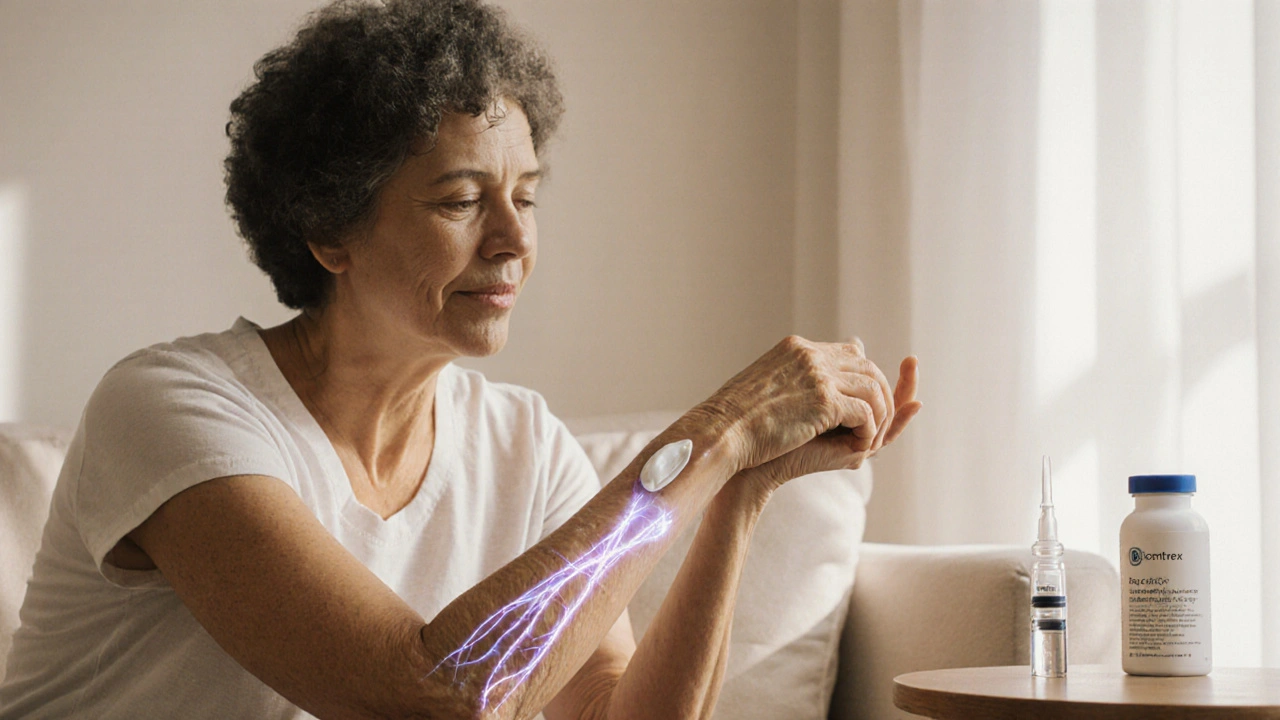Placentrex vs. Alternatives: Human Placental Extract Comparison Guide 2025
 Oct, 13 2025
Oct, 13 2025
Placentrex Alternative Decision Guide
Find Your Ideal Option
Answer these questions to see which alternatives to Placentrex best match your needs.
Key Takeaways
- Placentrex is a human placental extract rich in nitrogen‑based growth factors, typically used for skin rejuvenation and joint support.
- Alternative options include bovine placental extract, marine collagen, PRP therapy, growth‑factor serums, and hyaluronic acid injections.
- Cost, evidence level, and administration method vary widely; Placentrex sits in the mid‑range for price but offers strong clinical backing.
- Potential side‑effects are generally mild but differ by source-animal‑derived extracts may trigger allergies, while injections carry infection risk.
- Choosing the right product depends on your specific goal, budget, and tolerance for invasive procedures.
When it comes to boosting skin health or easing joint discomfort, many people wonder whether Placentrex truly outperforms the crowded market of supplements and injectables. This guide breaks down the science, costs, and real‑world results of Placentrex and five popular alternatives, giving you the facts you need to decide what fits your routine.
What Is Placentrex?
Placentrex is a patented human placental extract that has been processed to retain high concentrations of nitrogen‑rich proteins, peptides, and growth factors. First introduced in the early 2000s, the product is marketed for skin regeneration, scar reduction, and joint lubrication. The extraction process removes cellular debris while preserving bioactive molecules such as epidermal growth factor (EGF), fibroblast‑stimulating peptide (FSP), and collagen‑supporting amino acids.

How Placentrex Works
At a cellular level, the nitrogen‑based components act as signalling agents that trigger fibroblast proliferation and collagen synthesis. In skin, this translates to improved elasticity, reduced fine lines, and faster wound healing. For joints, the same growth factors help maintain cartilage health by encouraging chondrocyte activity. Clinical trials in South Korea and Japan reported measurable improvements in skin thickness and joint pain scores after 8‑week regimens.
Top Alternatives to Consider
Before you decide, it helps to know what else is out there. Below are the most common substitutes, each introduced with a brief definition and key attributes.
Bovine Placental Extract
Bovine Placental Extract is derived from cow placenta and contains a similar mix of growth factors, though the protein profile differs slightly due to species variation. It is often sold in capsule or topical cream form and tends to be less expensive than the human‑derived version.
Marine Collagen
Marine Collagen comes from fish skin and scales, providing type I collagen peptides that are highly bioavailable. Unlike placental extracts, marine collagen focuses mainly on structural support rather than growth‑factor stimulation.
Platelet‑Rich Plasma (PRP) Therapy
PRP Therapy involves drawing a small amount of the patient’s own blood, centrifuging it to concentrate platelets, and re‑injecting the plasma into the target area. It delivers a natural cocktail of growth factors directly where they’re needed.
Growth Factor Serum
Growth Factor Serum is a cosmetic product that combines recombinant human growth factors (often EGF and VEGF) with a serum base for topical application. These serums aim to mimic the benefits of placental extracts without animal sourcing.
Hyaluronic Acid Injections
Hyaluronic Acid Injections are gel‑like fillers that attract and retain water in the dermis, providing immediate plumping and longer‑term collagen stimulation. While not a growth‑factor product, they are a popular alternative for skin rejuvenation.
Side‑by‑Side Comparison
| Attribute | Placentrex | Bovine Placental Extract | Marine Collagen | PRP Therapy | Growth Factor Serum | Hyaluronic Acid |
|---|---|---|---|---|---|---|
| Source | Human placenta (nitrogen‑rich extract) | Cow placenta | Fish skin & scales | Patient’s own blood | Recombinant human proteins | Synthetic hyaluronic gel |
| Main Active | EGF, FSP, collagen‑supporting peptides | Similar growth factors, lower EGF | Type I collagen peptides | Platelet‑derived growth factors (PDGF, TGF‑β) | EGF, VEGF, IGF‑1 | Hyaluronic acid, indirect collagen boost |
| Typical Use Cases | Skin rejuvenation, joint health | Skin & hair support | Skin elasticity, nail health | Acne scarring, joint repair | Fine lines, hyperpigmentation | Facial volume, deep wrinkles |
| Administration | Topical cream or injectable ampoule | Oral capsules or cream | Powder mixed in drinks | In‑office injection | Topical serum | In‑office injection |
| Cost (UK, 2025) | ~£120 for 10ml ampoules (4‑week course) | ~£80 for 30capsules | ~£60 for 200g powder | ~£250 per session | ~£70 for 30ml bottle | ~£180 per 1ml syringe |
| Evidence Level | Clinical trials (double‑blind) in Asia | Limited pilot studies | Numerous consumer trials | Strong dermatology & orthopedics data | Early‑stage research, mostly cosmetic | Well‑studied for volume, less for collagen |
| Side‑Effect Profile | Mild irritation, rare allergic response | Potential bovine protein allergy | Rare fish‑allergy reactions | Bruising, infection risk | Skin redness, sensitivity | Swelling, bruising, rare vascular occlusion |

How to Choose the Right Option
- Define your primary goal. If you need deep joint support, Placentrex or PRP are the strongest candidates. For surface‑level skin firmness, marine collagen or hyaluronic acid may suffice.
- Consider your budget. Top‑tier injectables like PRP and hyaluronic acid carry higher per‑session costs. Oral or topical supplements are more budget‑friendly.
- Check for sensitivities. Animal‑derived extracts can trigger allergies; fish‑allergic users should skip marine collagen.
- Assess tolerance for invasiveness. In‑office injections require needles and after‑care, whereas creams and powders are painless.
- Look at the evidence. Products backed by double‑blind trials (Placentrex, PRP) generally offer more reliable outcomes than early‑stage serums.
Potential Risks & Safety Tips
While most users report positive results, it’s smart to know the pitfalls.
- Placentrex: Always perform a patch test before full application. If you have a history of autoimmune disorders, consult a clinician.
- Bovine Extract: Verify the product is sourced from certified, hormone‑free farms to reduce contamination risk.
- Marine Collagen: Choose hydrolyzed forms for better absorption and avoid products with added sugars.
- PRP Therapy: Ensure the clinic follows sterile protocols. Multiple sessions may be needed for noticeable benefits.
- Growth Factor Serum: Look for products that disclose the exact growth factor concentration; vague marketing claims can be misleading.
- Hyaluronic Acid: Seek practitioners experienced in facial anatomy to minimize vascular complications.
Frequently Asked Questions
Is Placentrex safe for long‑term use?
Clinical data up to 12months show no serious adverse events when used as directed. However, rotating with other skin‑care actives can help prevent tolerance buildup.
How does Placentrex differ from bovine placental extract?
Human placenta contains higher levels of epidermal growth factor and has a nitrogen profile that more closely matches human tissue, leading to better cellular signaling than bovine sources.
Can I combine Placentrex with PRP therapy?
Yes, some clinics use Placentrex topically after PRP injections to boost the healing cascade. Always discuss timing with your practitioner to avoid overstimulation.
What’s the typical treatment schedule for Placentrex?
Most protocols suggest applying the cream twice daily for eight weeks, or receiving one injection per week for four weeks, followed by a maintenance phase every three months.
Are there any contraindications for Placentrex?
Pregnant or nursing individuals should avoid it, as the hormonal activity of placental extracts is not fully studied in these populations.
How quickly can I see results?
Users typically notice smoother skin texture within 3‑4 weeks and measurable joint comfort improvements after 6‑8 weeks, depending on dosage and consistency.
Bottom line: Placentrex offers a biologically rich mix of growth factors that many alternatives simply can’t match, especially for joint health. Still, if cost or needle aversion is a concern, marine collagen or a high‑quality growth factor serum can deliver respectable skin benefits. Weigh the evidence, your budget, and any allergy risks-then pick the path that aligns with your goals.
Dawn Mich
October 13, 2025 AT 22:07Don't be fooled by the glossy marketing of Placentrex; the pharma giants are pushing a human placenta cocktail to lock us into a dependency cycle. Every ampoule is a tiny Trojan horse delivering undisclosed growth factors that can mess with your endocrine balance. I say stay away until independent labs prove it's not a side‑effect soup. The data they show is cherry‑picked from clinics that owe them money. If you value real freedom, ditch the injectable and look for something nature‑based that isn’t sold by a conglomerate.
Eric Sevigny
October 21, 2025 AT 15:16Here’s a quick rundown of the main alternatives mentioned in the guide. For skin‑tightening, marine collagene is a solid, budget‑friendly option and you can mix the powder in your morning smoothie. If you’re after joint support, PRP therapy has the strongest clinical backing, though it does cost more per session. Bovine placental extract works for many who can’t afford human‑derived products, but watch out for possible animal‑protein allergies. Remember to patch‑test any new topical before you apply it all over.
Glenda Rosa
October 29, 2025 AT 08:24First, let’s acknowledge the obvious: the hype machine surrounding Placentrex is as loud as a brass band in a library, and yet the scientific chorus is barely a whisper. While the manufacturer touts “nitrogen‑rich growth factors,” most independent researchers have yet to replicate those results in a double‑blind setting. In contrast, marine collagen has been dissected in dozens of peer‑reviewed studies, showing modest but consistent improvements in dermal elasticity. The bovine counterpart, on the other hand, suffers from inter‑species variability that makes dosing a guessing game. PRP therapy, despite its pricey tag, enjoys a robust evidence base from orthopedics and dermatology alike, which the placental extracts simply cannot match. Moreover, the extraction process for human placenta is riddled with ethical quandaries that most consumers overlook in their quest for a youthful glow. The regulatory oversight for these extracts varies wildly across jurisdictions, leaving a patchwork of quality standards that can include contaminants. If you examine the cost‑benefit matrix, Placentrex lands in the middle ground: not cheap enough to be a “budget” supplement, yet not as effective as proven biologics. Users frequently report mild irritation, which is essentially a red flag that the formulation may be too aggressive for sensitive skin types. Allergic reactions, while rare, have been documented in individuals with prior exposure to animal proteins, suggesting cross‑reactivity that the manufacturers conveniently ignore. The growth‑factor serum, marketed with a fancy label, actually contains recombinant proteins that are far less complex than the native cocktail found in human placenta. Hyaluronic acid injections, though primarily a volumizing filler, have secondary benefits for collagen synthesis, making them a versatile option for those wary of biologics. From a mechanistic standpoint, the signaling pathways triggered by EGF in Placentrex are well‑understood, but the downstream effects are dampened by the presence of unknown ancillary molecules. In practice, many dermatologists recommend pairing a low‑dose Placentrex regimen with a proven collagen peptide supplement to hedge the uncertainty. Ultimately, the decision hinges on personal risk tolerance, budget constraints, and how much faith you place in proprietary claims versus open‑access research. So before you splash your hard‑earned cash on a ten‑milliliter ampoule, weigh these factors carefully and consider consulting a practitioner who isn’t on the product’s payroll.
Aaron Perez
November 6, 2025 AT 01:33One might wonder, in the grand tapestry of dermal rejuvenation, whether the allure of a placental elixir transcends mere chemistry; it invites a contemplation of identity, of self‑renewal, and of the very narratives we construct around aging-yet, the empirical data remains stubbornly mute; therefore, a cautious skeptic must balance poetic yearning with cold, hard metrics, lest we become worshippers of a fad, sacrificing reason at the altar of vanity.
William Mack
November 13, 2025 AT 18:41Consider the cultural context: many Asian beauty routines have already embraced placental extracts for generations, offering a historical anchor that modern hype can’t erase.
Evan Riley
November 21, 2025 AT 11:50It’s no coincidence that the same labs pushing Placentrex also fund the next wave of gene‑editing clinics; they’re banking on our desperation to stitch together a market where control of our own cells is outsourced to corporate behemoths, and the public remains blissfully ignorant.
Nicole Povelikin
November 29, 2025 AT 04:58i think the guide could use more info on how the extraction process actually works, because if theyre not cleaning it properly you could end up with unwanted hormones lingering in the product.